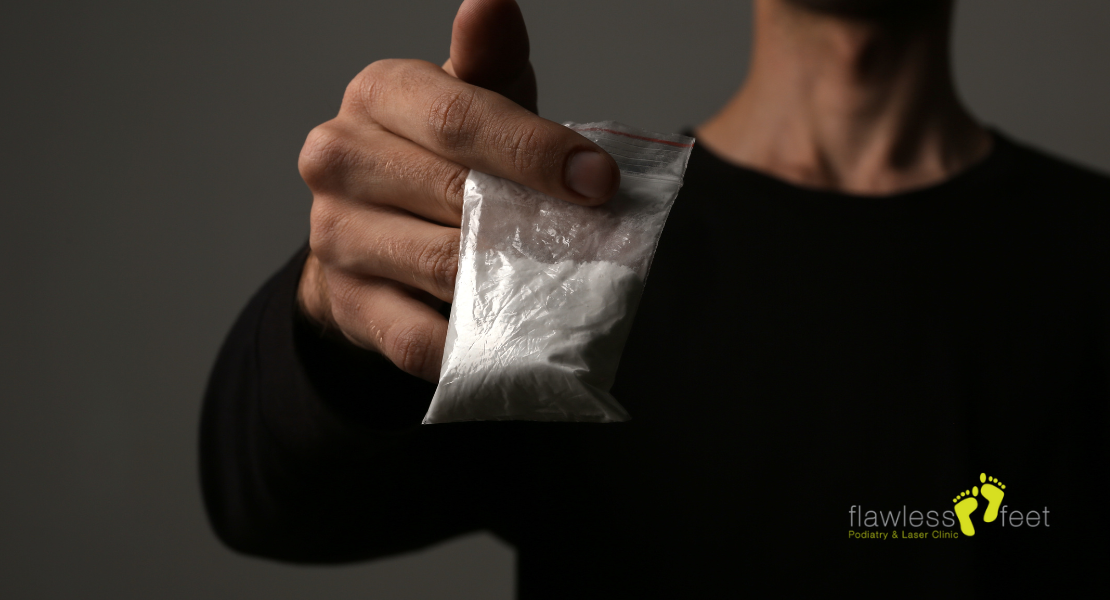
One of The Flawless Feet podiatrists has written this blog to help anyone taking cocaine. We want people to know that damage it can do
to the body as a whole, the skin and the feet.
We never judge as of our patient's lifestyle choices, we are here to advise and treat, to help as many people as possible. If you or anyone
you know needs this, please pass on our contact details.
As podiatrists, we learn a lot about the skin, the blood flow around the body and how they can be affected. Here are some symptoms to look out for.
We can help to ease the symptoms, get in contact with us.
Talk To Frank website.
Please continue reading if you'd like to know more about the medical conditions associated with cocaine use.
COCAINE - Also called coke or crack, cocaine is a central nervous system stimulant that’s illegally manufactured, trafficked, and sold all
around the world. It has a reputation for being one of the most addictive and dangerous drugs on the market. In addition to the various
effects of excessive cocaine use – such as addiction and cardiovascular disease – skin disease has also been reported among users. Today,
we’re sharing a list of common cocaine skin problems that may indicate a deeper problem.
Cocaine is a vasoconstrictor, which makes the heart pump faster while narrowing the blood vessels. Long-term use can lead to atherosclerosis and coronary artery disease, or hardening of the arteries or capillaries. Circulation is therefore reduced in cocaine users, and leads to a risk of peripheral arterial disease and in more severe cases, amputation. Cocaine use can also contribute to the formation of fibrous tissue in the skin, limb ischaemia and neuropathy. Cocaine was traditionally used as an anaesthetic. As with alcohol, overuse can cause permanent damage to the nerves, which is irreversible.
The long-term effects of cocaine use on the skin are also the result of one of its most common ingredients: levamisole. Also known by its brand name Ergamisol, levamisole is a medication used to treat parasitic worm infections. Before it was banned from being used on humans, levamisole was prescribed to treat conditions like rheumatoid arthritis and leukemia in the past. However, it was discontinued in 2000 due to adverse side effects like neutropenia (abnormally low white blood cell count), agranulocytosis, vasculitis (inflammation of the blood vessels), and of course, skin necrosis (death of skin cells). However, despite being banned for use in people, levamisole is a common ingredient in cocaine.
Cocaine is also known to produce vasoconstriction or constricting of the blood vessels. This is a significant reason why long-term cocaine use can attack the skin. Vasoconstriction restricts blood flow to certain areas of the body, including the skin. When the skin doesn’t receive enough blood and oxygen, it can’t heal itself as quickly or efficiently. In the end, not only is the skin placed in a position where it’s more vulnerable to disease, but healing is also greatly inhibitor
Cocaine's main vasoactive metabolite benzoylmethylecgonine, a tropane alkaloid, is a sodium channel blocker, which produces enhanced sympathetic activity at low doses At high doses, cocaine is markedly more dangerous than other central nervous system estimulants, including amphetamines and can cause sudden cardiac death through its effect on sodium channels and local anesthetic actions.
Cocaine crosses the blood–brain-barrier perhaps better than other psychoactive chemicals and may even induce its breakdown. In addition, cocaine blocks reuptake of catecholamines in the presynaptic neurons in the central and peripheral nervous systems, resulting in increased catecholamines, sympathetic output and stimulation. Stimulation of dopamine cells in the ventral tagmental area increases blood pressure and this effect is antagonized by the dopamine D2 receptor blockers .
Cocaine releases endothelin-145, which is found to be elevated in CUD and declines with detoxification. When vessels are stressed, endothelin-1 (a vasoconstrictor protein produced by vascular endothelial cells) is elevated and nitric oxide (a blood vessel dilator) decreases, leading to vasoconstriction .
Additional mechanisms implicated in cocaine induced vasoconstriction include increases in calcium. In cases of acute damage, when stress leads to rupture in vessels, endothelial damage promotes the increase of fibrinogen (glycoprotein, which helps in formation of blood clots) and Von Willebrand factor (glycoprotein signaling endothelium changes), leading to platelet aggregation and ultimately the formation of blood clots This cascade reduces blood flow following cocaine use and can lead to acute organ damage.
Cocaine creates an elevated immune system inflammatory state with decreased basal anti-inflammatory markers, and increased pro-inflammatory cytokines, all contributing to vascular disease .
Cocaine's chronic effects on the vessel consist of repeated endothelial damage leading to premature and severe atherosclerosis in various organs.
Cocaine is responsible of endothelial dysfunction and accelerated atherosclerosis with consequent organ damage. Cocaine abuse is not only associated with central necrotizing vasculitis, but it is also appeared to play a role in the development of peripheral vasoconstriction with symptoms similar to Buerger's disease.
The full etiology underlying cocaine's acute neurotoxicity is multifactorial with similar mechanisms that also underlie its cardiotoxicity effects, spanning hypertension, impaired homeostasis and platelet function (aggregation), thrombosis, thromboembolism, decreased cerebral blood flow (CBF), and focal perfusion deficits .
Common cocaine effects on the skin include:
.png)
Learn all about corns, their causes, types, and prevention methods from Flawless Feet. Discover effective treatments, from short-term relief to long-term solutions, provided by our expert podiatrists at Flawless Feet.
.png)
Discover how to prevent and treat common CrossFit and Hyrox injuries with expert tips from a London-based podiatrist. Learn about proper footwear, effective warm-ups, and advanced treatment options to keep your feet healthy and your performance at its peak